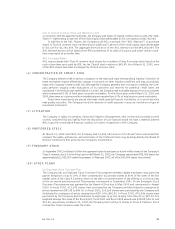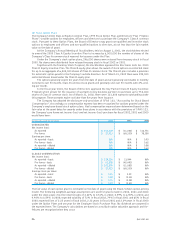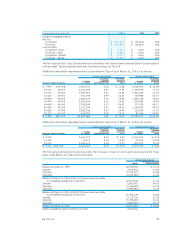Electronic Arts 2002 Annual Report Download - page 67
Download and view the complete annual report
Please find page 67 of the 2002 Electronic Arts annual report below. You can navigate through the pages in the report by either clicking on the pages listed below, or by using the keyword search tool below to find specific information within the annual report.
The Company provides for U.S. taxes on an insignificant portion of the undistributed earnings of its foreign
subsidiaries and does not provide taxes on the remainder.The Company has not provided for Federal income
tax on approximately $259,000,000 of undistributed earnings of its foreign subsidiaries, since the Company
intends to reinvest this amount in foreign subsidiary operations indefinitely.
At March 31, 2002, the Company believes it is more likely than not that the results of future opera-
tions will generate sufficient taxable income to realize the net deferred tax assets.
The Company’s U.S. income tax returns for the years 1992 through 1995 have been examined by the
Internal Revenue Service (IRS). In 1998, the Company received a notice of deficiencies from the IRS.These
deficiencies relate primarily to operations in Puerto Rico, which the Company is contesting in Tax Court.The
Company substantially prevailed with respect to the principal issues at the Tax Court level.The time for the
IRS to appeal has not yet expired.The Company believes that additional liabilities, if any, that arise from the
outcome of this examination will not be material to the Company’s consolidated financial statements.
(15) INTEREST AND OTHER INCOME, NET
Interest and other income, net for the years ended March 31, 2002, 2001 and 2000 consisted of:
(In thousands) 2002 2001 2000
Interest income $16,691 $17,903 $ 13,744
Gain (loss) on disposition of assets, net (131) (1,778) 8,339
Foreign currency losses (412) (888) (1,781)
Foreign currency cost of hedging (3,032) ——
Equity in net gain of affiliates 2,999 820 1,138
Other income (expense), net (3,267) 829 (5,412)
$12,848 $16,886 $ 16,028
(16) COMPREHENSIVE INCOME
Statement of Financial Accounting Standards No. 130 (“SFAS 130”) requires classification of other com-
prehensive income in a financial statement and display of other comprehensive income separately from
retained earnings and additional paid-in capital. Other comprehensive income includes primarily foreign
currency translation adjustments and unrealized gains (losses) on investments.
The change in the components of comprehensive income, net of tax, is summarized as follows (in thousands):
FOREIGN CURRENCY UNREALIZED GAINS ACCUMULATED
TRANSLATION (LOSSES) ON OTHER COMPRE-
ADJUSTMENTS INVESTMENTS HENSIVE LOSS
Balance at March 31, 1999 $ (5,841) $ 3,274 $ (2,567)
Other comprehensive loss (339) (3,455) (3,794)
Balance at March 31, 2000 (6,180) (181) (6,361)
Other comprehensive income (loss) (9,439) 3,097 (6,342)
Balance at March 31, 2001 (15,619) 2,916 (12,703)
Other comprehensive income (loss) 1,453 (3,474) (2,021)
Balance at March 31, 2002 $(14,166) $ (558) $ (14,724)
Change in unrealized gains (losses) on investments, net are shown net of taxes of $(1,561,000),
$1,391,000 and $(1,553,000) in fiscal 2002, 2001 and 2000, respectively.
The currency translation adjustments are not adjusted for income taxes as they relate to indefinite
investments in non-U.S. subsidiaries.
(17) DISCLOSURES ABOUT FAIR VALUE OF FINANCIAL INSTRUMENTS
The following methods and assumptions were used to estimate the fair value of each class of financial
instruments for which it is practicable to estimate that value:
Cash, cash equivalents, short-term investments, receivables, accounts payable and accrued liabilities –
the carrying amount approximates fair value because of the short maturity of these instruments.
Long-term investments, investments classified as held-to-maturity and marketable securities –
fair
value is based on quoted market prices.
EA 2002 AR 63





















